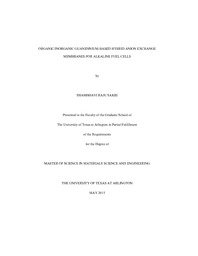| dc.description.abstract | Organic-inorganic hybrid membranes are good alternatives to homogeneous ones to overcome the limitations posed by the individual constituent materials. These membranes pose promising applications in fuel cells with the combination of phenomenal functionality of organic polymers and stability of inorganic material. Introduction of inorganic materials into the polymer matrix is usually known to show an increase in mechanical properties of the membrane while, the organic part of the membrane, i.e., the polymer contributes towards the electrochemical properties. The properties of the individual materials combine to enhance the characteristic properties of the hybrid membranes. In this thesis we attempted to develop guanidinium-based hybrid membranes using inorganic montmorillonite(clay) particles. These layered silicate nanoparticles were discovered to increase the membrane properties such as tensile moduli, toughness at filler content as small as 1%. As widely reported in literature, the clay particles are known to interact with polymer matrix through adsorption, intercalation and cation exchange. Hence, we have tried to form interaction between the clay particles and the guanidinium based polymer (formed through condensation reaction between hexamethylenediamine and guanidinium hydrochloride) through ion exchange. The guanidinium based polymers have previously displayed high conductivity (nearly 84.7m S cm⁻1 obtained at 20⁰C in DI water) due to their high basicity and resonance structure. However, they suffer from poor mechanical stability at high ion exchange capacity and tend to become brittle when dry. Hence we have tried to incorporate montmorillonite inthe polymer to obtain a hybrid membrane which yields an additional mechanical stability to the material along with the high conductivity. This material is used for casting a hybrid anion exchange membrane for application in fuel cells.The crux of this thesis focuses on identifying how the properties of the material such as mechanical strength, stability, ionic conductivity, viscosity and texture changes on addition of the clay in different proportions.Specifically, polymer material with different percentage of clay (0%, 1%, 3%) clay were prepared and their properties were thoroughly investigated. Using the FTIR, Raman, Tensile Testing, and AC impedence spectroscopy, we characterized the membranes with different percentages of clay for the aforementioned properties. | en_US |

